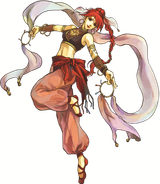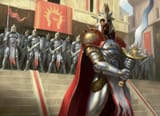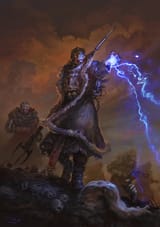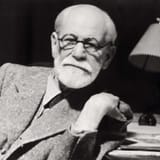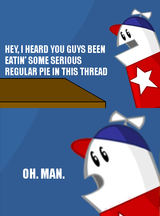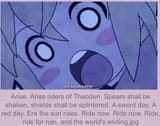Anonymous
8/11/2025, 9:01:15 PM
No.96298364
[Report]
>>96298872
>>96298970
>>96299426
>>96299654
>>96299846
>>96299912
>>96299922
>>96300086
>>96311192
>>96311226
>>96319299
>>96325434
Warlord
What do you think of the D&D 4e warlord and its descendants?
D&D 3.5's Tome of Battle laid some of the groundwork with the White Raven discipline. D&D 4e's warlord, though, really captured the package of a nonmagical leader/support/buffing/healing class. It was one of D&D 4e's strongest leader classes.
Since then, other tactics-oriented games have followed suit: 13th Age's commander, Strike!'s warlord, Fabula Ultima's commander, Pathfinder 2e's commander (and, to a lesser extent, Starfinder 2e's envoy), and Draw Steel's tactician, among others. Draw Steel is notable in that it has no generic "soldierly fighter" class, instead folding the concept into the tactician, particularly its vanguard subclass.
All of these have an ability that lets an ally make an attack instead of the warlord themselves. This is strong and flexible because it allows exactly the right PC to make exactly the right attack against exactly the right enemy (and possibly with accuracy/damage buffs, perhaps from the warlord). Flavor-wise, this represents being a leader so incisive and inspiring that they can point out an opening an spur an ally to push past their limits, for just one crucial moment.
These warlords have a narrative aspect to their abilities. They are not manipulating time or shouting wounds closed. The game allows the player to declare that, yes, there is an opening right here and right now, and that the warlord can point it out; or that the injuries are not so bad after all, and that the warlord's words are enough to let an ally ignore the pain.
D&D 5(.5)e has yet to produce a first-party warlord. At best, some Battle Master and Purple Dragon Knight features can splash a vague facsimile of warlord-like abilities, but the character is still a fighter first and foremost, better at personally fighting than at barking out orders.
Daggerheart does not have a warlord. It seems hard to implement warlord-like mechanics into the system, given its lack of a traditional turn structure.
D&D 3.5's Tome of Battle laid some of the groundwork with the White Raven discipline. D&D 4e's warlord, though, really captured the package of a nonmagical leader/support/buffing/healing class. It was one of D&D 4e's strongest leader classes.
Since then, other tactics-oriented games have followed suit: 13th Age's commander, Strike!'s warlord, Fabula Ultima's commander, Pathfinder 2e's commander (and, to a lesser extent, Starfinder 2e's envoy), and Draw Steel's tactician, among others. Draw Steel is notable in that it has no generic "soldierly fighter" class, instead folding the concept into the tactician, particularly its vanguard subclass.
All of these have an ability that lets an ally make an attack instead of the warlord themselves. This is strong and flexible because it allows exactly the right PC to make exactly the right attack against exactly the right enemy (and possibly with accuracy/damage buffs, perhaps from the warlord). Flavor-wise, this represents being a leader so incisive and inspiring that they can point out an opening an spur an ally to push past their limits, for just one crucial moment.
These warlords have a narrative aspect to their abilities. They are not manipulating time or shouting wounds closed. The game allows the player to declare that, yes, there is an opening right here and right now, and that the warlord can point it out; or that the injuries are not so bad after all, and that the warlord's words are enough to let an ally ignore the pain.
D&D 5(.5)e has yet to produce a first-party warlord. At best, some Battle Master and Purple Dragon Knight features can splash a vague facsimile of warlord-like abilities, but the character is still a fighter first and foremost, better at personally fighting than at barking out orders.
Daggerheart does not have a warlord. It seems hard to implement warlord-like mechanics into the system, given its lack of a traditional turn structure.

